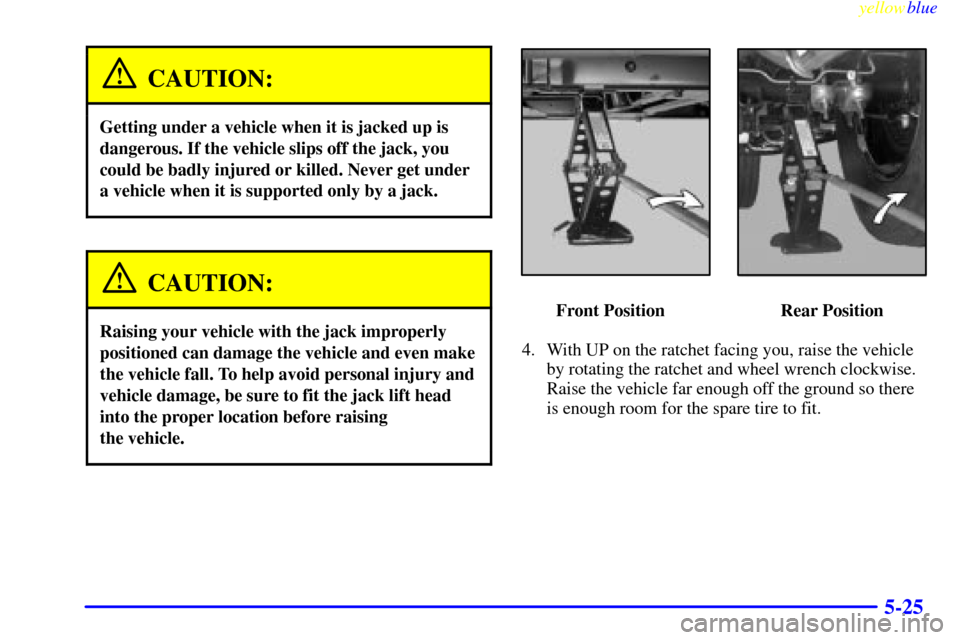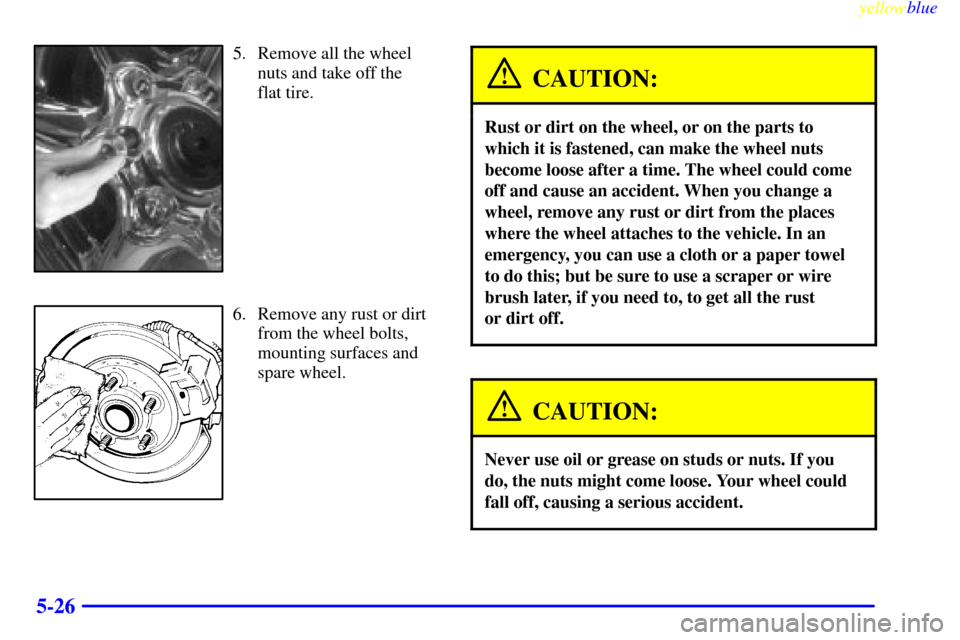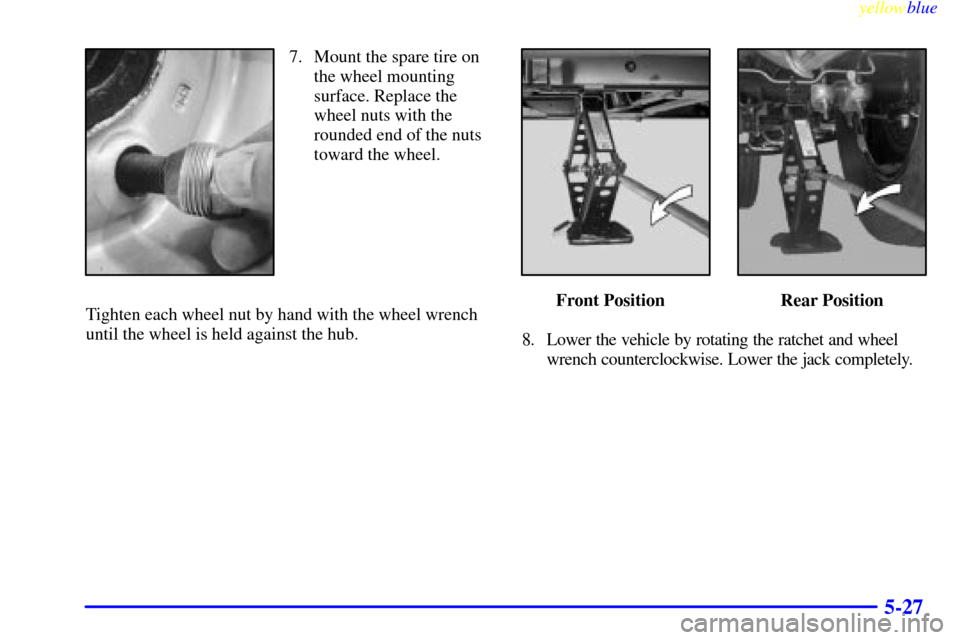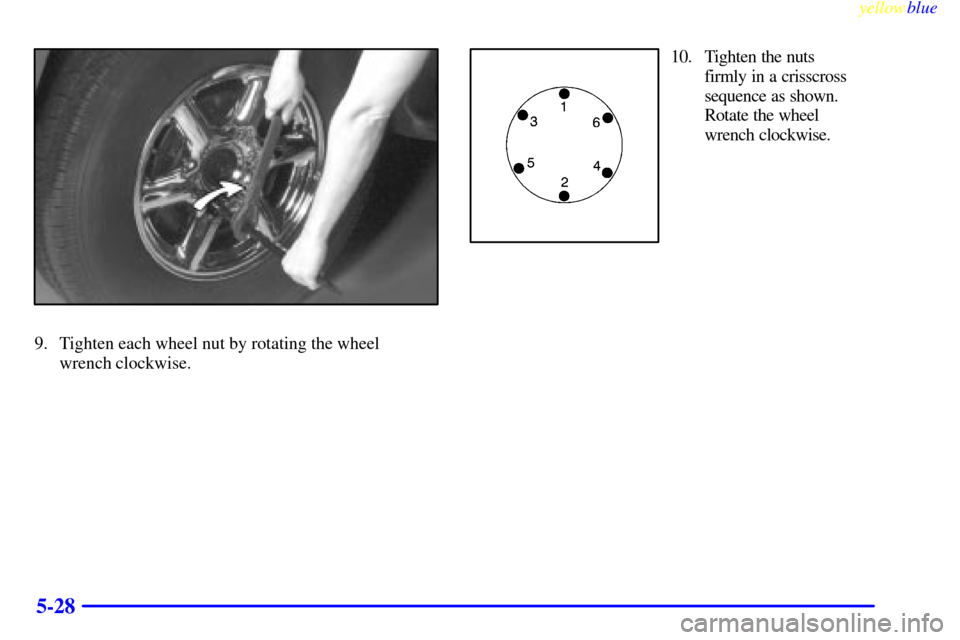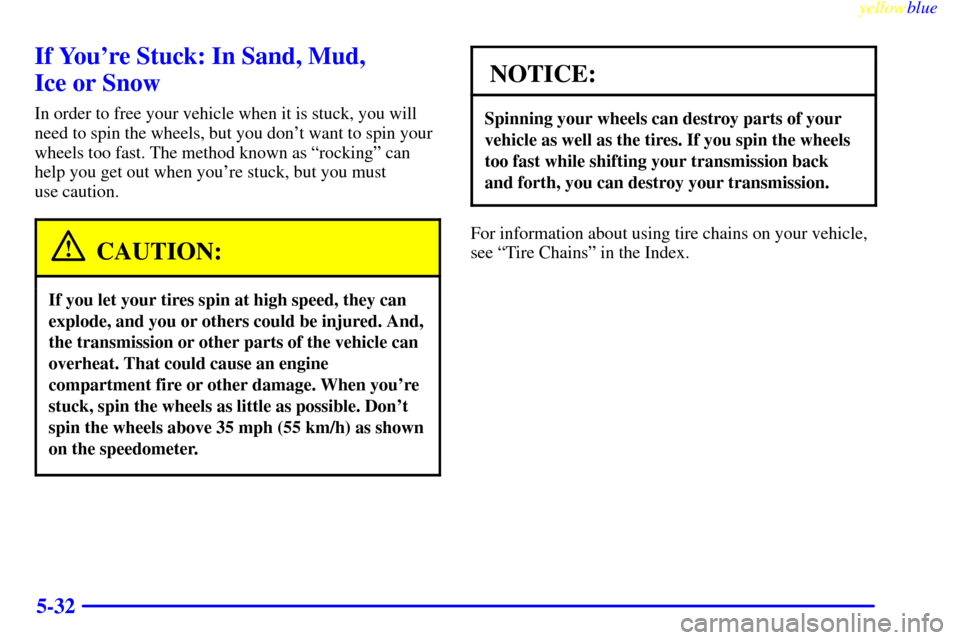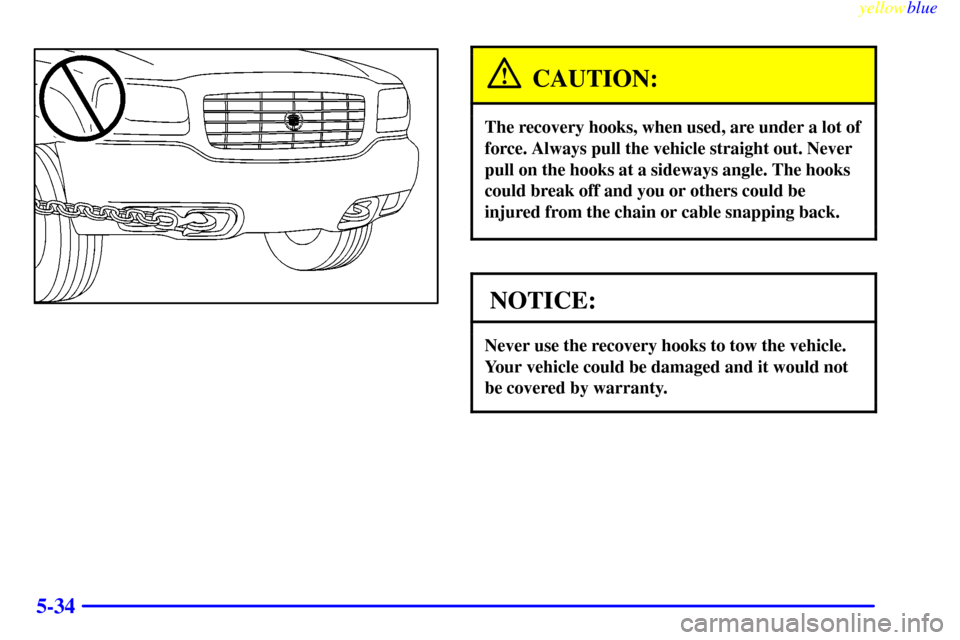CADILLAC ESCALADE 1999 1.G Owners Manual
ESCALADE 1999 1.G
CADILLAC
CADILLAC
https://www.carmanualsonline.info/img/23/7918/w960_7918-0.png
CADILLAC ESCALADE 1999 1.G Owners Manual
Trending: ignition, jump start terminals, start stop button, windshield wipers, odometer, change wheel, fuel filter
Page 251 of 352
yellowblue
5-25
CAUTION:
Getting under a vehicle when it is jacked up is
dangerous. If the vehicle slips off the jack, you
could be badly injured or killed. Never get under
a vehicle when it is supported only by a jack.
CAUTION:
Raising your vehicle with the jack improperly
positioned can damage the vehicle and even make
the vehicle fall. To help avoid personal injury and
vehicle damage, be sure to fit the jack lift head
into the proper location before raising
the vehicle.
Front Position Rear Position
4. With UP on the ratchet facing you, raise the vehicle
by rotating the ratchet and wheel wrench clockwise.
Raise the vehicle far enough off the ground so there
is enough room for the spare tire to fit.
Page 252 of 352
yellowblue
5-26
5. Remove all the wheel
nuts and take off the
flat tire.
6. Remove any rust or dirt
from the wheel bolts,
mounting surfaces and
spare wheel.
CAUTION:
Rust or dirt on the wheel, or on the parts to
which it is fastened, can make the wheel nuts
become loose after a time. The wheel could come
off and cause an accident. When you change a
wheel, remove any rust or dirt from the places
where the wheel attaches to the vehicle. In an
emergency, you can use a cloth or a paper towel
to do this; but be sure to use a scraper or wire
brush later, if you need to, to get all the rust
or dirt off.
CAUTION:
Never use oil or grease on studs or nuts. If you
do, the nuts might come loose. Your wheel could
fall off, causing a serious accident.
Page 253 of 352
yellowblue
5-27
7. Mount the spare tire on
the wheel mounting
surface. Replace the
wheel nuts with the
rounded end of the nuts
toward the wheel.
Tighten each wheel nut by hand with the wheel wrench
until the wheel is held against the hub.
Front Position Rear Position
8. Lower the vehicle by rotating the ratchet and wheel
wrench counterclockwise. Lower the jack completely.
Page 254 of 352
yellowblue
5-28
9. Tighten each wheel nut by rotating the wheel
wrench clockwise.
10. Tighten the nuts
firmly in a crisscross
sequence as shown.
Rotate the wheel
wrench clockwise.
Page 255 of 352
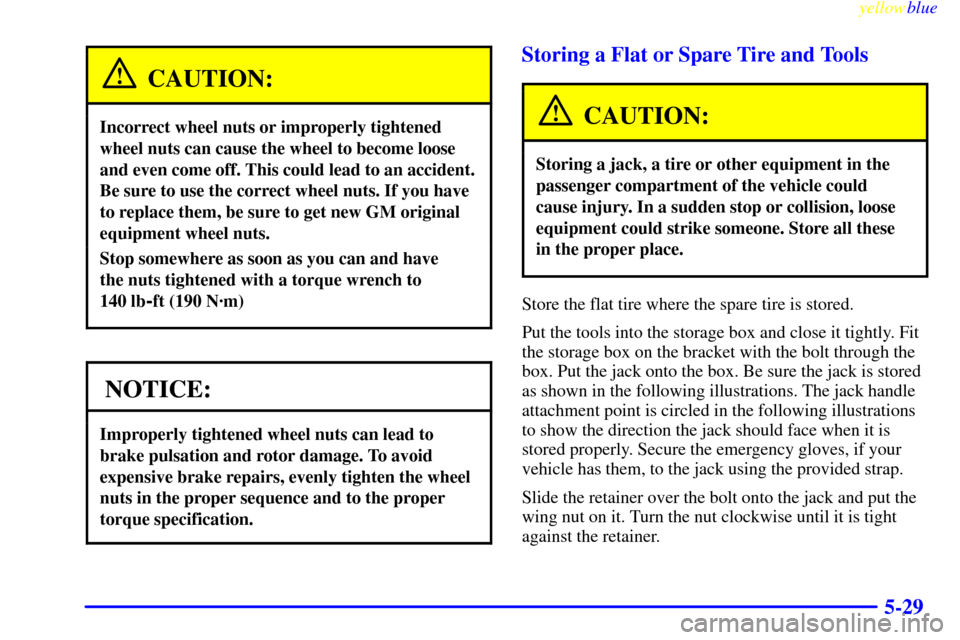
yellowblue
5-29
CAUTION:
Incorrect wheel nuts or improperly tightened
wheel nuts can cause the wheel to become loose
and even come off. This could lead to an accident.
Be sure to use the correct wheel nuts. If you have
to replace them, be sure to get new GM original
equipment wheel nuts.
Stop somewhere as soon as you can and have
the nuts tightened with a torque wrench to
140 lb
-ft (190 N´m)
NOTICE:
Improperly tightened wheel nuts can lead to
brake pulsation and rotor damage. To avoid
expensive brake repairs, evenly tighten the wheel
nuts in the proper sequence and to the proper
torque specification.
Storing a Flat or Spare Tire and Tools
CAUTION:
Storing a jack, a tire or other equipment in the
passenger compartment of the vehicle could
cause injury. In a sudden stop or collision, loose
equipment could strike someone. Store all these
in the proper place.
Store the flat tire where the spare tire is stored.
Put the tools into the storage box and close it tightly. Fit
the storage box on the bracket with the bolt through the
box. Put the jack onto the box. Be sure the jack is stored
as shown in the following illustrations. The jack handle
attachment point is circled in the following illustrations
to show the direction the jack should face when it is
stored properly. Secure the emergency gloves, if your
vehicle has them, to the jack using the provided strap.
Slide the retainer over the bolt onto the jack and put the
wing nut on it. Turn the nut clockwise until it is tight
against the retainer.
Page 256 of 352
yellowblue
5-30
Replace the jack storage cover by simply reversing the
removal procedure described earlier.
Jacking Tool Storage
A. Wheel Wrench
B. Jack Handle
C. RatchetD. Jacking Tool Storage Box
E. Jack Handle Extension
Jack Storage
A. Retainer
B. Nut
C. JackD. Jack Storage Box
E. Bracket
Page 257 of 352
yellowblue
5-31
Spare Tire Storage
A. Hoist Assembly
B. Hoist Shaft
C. Ratchet
D. Jack HandleE. Retainer
F. Valve Stem, Pointed Down
G. Spare TireFollow these instructions to restore a spare or flat tire:
1. Lay the tire on the ground at the rear of the vehicle.
Position the tire so that the valve stem is pointed
down and to the rear of the vehicle.
2. Tilt the retainer downward and through the wheel
opening. Make sure that the retainer is fully seated
across the underside of the wheel.
3. Attach the ratchet, with the UP mark facing you,
near the hook at the end of the jack handle. Insert the
other end, on an angle, through the hole in the rear
bumper and into the hoist shaft.
4. Raise the tire fully against the underside of the
vehicle. Continue turning the ratchet clockwise until
there are two ªclicksº or ªratchets.º The spare tire
hoist cannot be over
-tightened.
5. Grasp and push against the tire to be sure it is stored
securely and does not move.
Page 258 of 352
yellowblue
5-32
If You're Stuck: In Sand, Mud,
Ice or Snow
In order to free your vehicle when it is stuck, you will
need to spin the wheels, but you don't want to spin your
wheels too fast. The method known as ªrockingº can
help you get out when you're stuck, but you must
use caution.
CAUTION:
If you let your tires spin at high speed, they can
explode, and you or others could be injured. And,
the transmission or other parts of the vehicle can
overheat. That could cause an engine
compartment fire or other damage. When you're
stuck, spin the wheels as little as possible. Don't
spin the wheels above 35 mph (55 km/h) as shown
on the speedometer.
NOTICE:
Spinning your wheels can destroy parts of your
vehicle as well as the tires. If you spin the wheels
too fast while shifting your transmission back
and forth, you can destroy your transmission.
For information about using tire chains on your vehicle,
see ªTire Chainsº in the Index.
Page 259 of 352

yellowblue
5-33 Rocking Your Vehicle To Get It Out
First, turn your steering wheel left and right. That will
clear the area around your front wheels. Shift the
transfer case into 4HI. Then shift back and forth
between REVERSE (R) and a forward gear, spinning the
wheels as little as possible. Release the accelerator pedal
while you shift, and press lightly on the accelerator
pedal when the transmission is in gear. By slowly
spinning your wheels in the forward and reverse
directions, you will cause a rocking motion that may
free your vehicle. If that doesn't get you out after a few
tries, you may need to be towed out. Or, you can use
your recovery hooks if your vehicle has them. If you do
need to be towed out, see ªTowing Your Vehicleº in
the Index.
Using the Recovery Hooks
Your vehicle is equipped with recovery hooks. The
recovery hooks are provided at the front of your vehicle.
You may need to use them if you're stuck off
-road and
need to be pulled to some place where you can
continue driving.
Page 260 of 352
yellowblue
5-34
CAUTION:
The recovery hooks, when used, are under a lot of
force. Always pull the vehicle straight out. Never
pull on the hooks at a sideways angle. The hooks
could break off and you or others could be
injured from the chain or cable snapping back.
NOTICE:
Never use the recovery hooks to tow the vehicle.
Your vehicle could be damaged and it would not
be covered by warranty.
Trending: driver seat adjustment, washer fluid, mileage, check transmission fluid, jump start, wheel size, light
